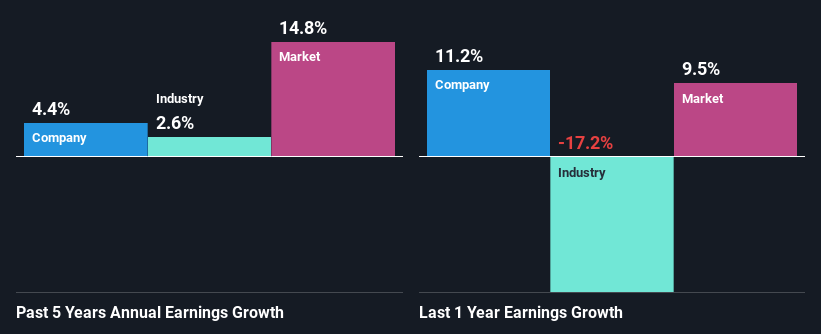Should Weakness in Vitrolife AB (publ)'s (STO:VITR) Stock Be Seen As A Sign That Market Will Correct The Share Price Given Decent Financials?

Vitrolife (STO:VITR) has had a rough three months with its share price down 34%. However, the company's fundamentals look pretty decent, and long-term financials are usually aligned with future market price movements. In this article, we decided to focus on Vitrolife's ROE.
Return on Equity or ROE is a test of how effectively a company is growing its value and managing investors’ money. In other words, it is a profitability ratio which measures the rate of return on the capital provided by the company's shareholders.
Check out our latest analysis for Vitrolife
How Do You Calculate Return On Equity?
Return on equity can be calculated by using the formula:
Return on Equity = Net Profit (from continuing operations) ÷ Shareholders' Equity
So, based on the above formula, the ROE for Vitrolife is:
2.2% = kr386m ÷ kr18b (Based on the trailing twelve months to June 2023).
The 'return' is the profit over the last twelve months. So, this means that for every SEK1 of its shareholder's investments, the company generates a profit of SEK0.02.
What Has ROE Got To Do With Earnings Growth?
So far, we've learned that ROE is a measure of a company's profitability. We now need to evaluate how much profit the company reinvests or "retains" for future growth which then gives us an idea about the growth potential of the company. Generally speaking, other things being equal, firms with a high return on equity and profit retention, have a higher growth rate than firms that don’t share these attributes.
A Side By Side comparison of Vitrolife's Earnings Growth And 2.2% ROE
It is quite clear that Vitrolife's ROE is rather low. Not just that, even compared to the industry average of 11%, the company's ROE is entirely unremarkable. Thus, the low net income growth of 4.4% seen by Vitrolife over the past five years could probably be the result of it having a lower ROE.
As a next step, we compared Vitrolife's net income growth with the industry, and pleasingly, we found that the growth seen by the company is higher than the average industry growth of 2.6%.

The basis for attaching value to a company is, to a great extent, tied to its earnings growth. It’s important for an investor to know whether the market has priced in the company's expected earnings growth (or decline). Doing so will help them establish if the stock's future looks promising or ominous. Is VITR fairly valued? This infographic on the company's intrinsic value has everything you need to know.
Is Vitrolife Efficiently Re-investing Its Profits?
While Vitrolife has a decent three-year median payout ratio of 29% (or a retention ratio of 71%), it has seen very little growth in earnings. Therefore, there might be some other reasons to explain the lack in that respect. For example, the business could be in decline.
Additionally, Vitrolife has paid dividends over a period of at least ten years, which means that the company's management is determined to pay dividends even if it means little to no earnings growth. Upon studying the latest analysts' consensus data, we found that the company is expected to keep paying out approximately 33% of its profits over the next three years. However, Vitrolife's ROE is predicted to rise to 4.4% despite there being no anticipated change in its payout ratio.
Conclusion
In total, it does look like Vitrolife has some positive aspects to its business. Even in spite of the low rate of return, the company has posted impressive earnings growth as a result of reinvesting heavily into its business. Having said that, looking at the current analyst estimates, we found that the company's earnings are expected to gain momentum. To know more about the latest analysts predictions for the company, check out this visualization of analyst forecasts for the company.
If you're looking to trade Vitrolife, open an account with the lowest-cost platform trusted by professionals, Interactive Brokers.
With clients in over 200 countries and territories, and access to 160 markets, IBKR lets you trade stocks, options, futures, forex, bonds and funds from a single integrated account.
Enjoy no hidden fees, no account minimums, and FX conversion rates as low as 0.03%, far better than what most brokers offer.
Sponsored ContentNew: Manage All Your Stock Portfolios in One Place
We've created the ultimate portfolio companion for stock investors, and it's free.
• Connect an unlimited number of Portfolios and see your total in one currency
• Be alerted to new Warning Signs or Risks via email or mobile
• Track the Fair Value of your stocks
Have feedback on this article? Concerned about the content? Get in touch with us directly. Alternatively, email editorial-team (at) simplywallst.com.
This article by Simply Wall St is general in nature. We provide commentary based on historical data and analyst forecasts only using an unbiased methodology and our articles are not intended to be financial advice. It does not constitute a recommendation to buy or sell any stock, and does not take account of your objectives, or your financial situation. We aim to bring you long-term focused analysis driven by fundamental data. Note that our analysis may not factor in the latest price-sensitive company announcements or qualitative material. Simply Wall St has no position in any stocks mentioned.
About OM:VITR
Vitrolife
Provides assisted reproduction products in Europe, the Middle East, Africa, Asia-Pacific, and the Americas.
Undervalued with adequate balance sheet.
Similar Companies
Market Insights
Community Narratives



